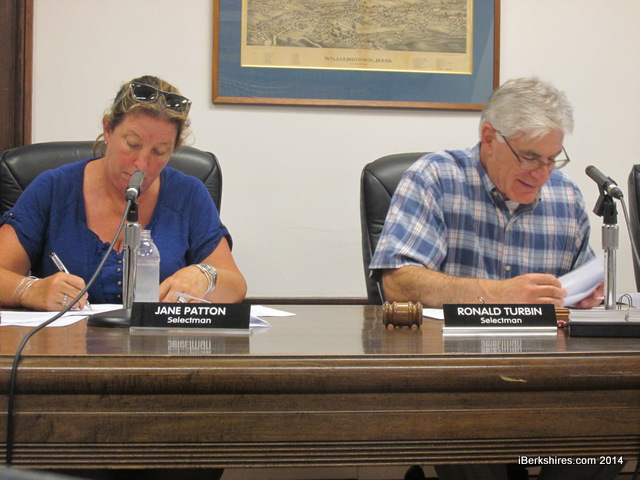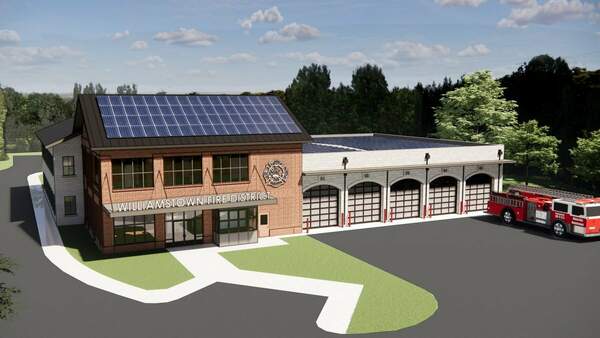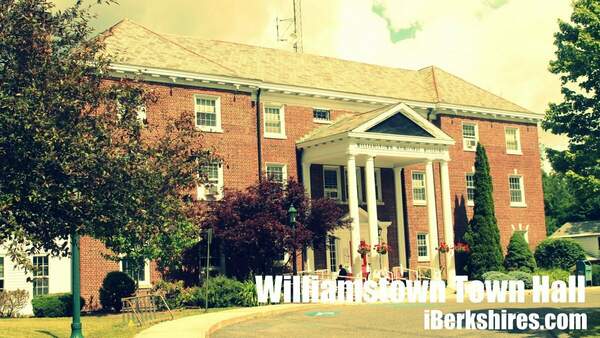Williamstown Town, Fire Discuss Coordinating Annual Meetings
 Selectmen Chairman Ronald Turbin and Jane Patton review minutes from a prior meeting on Monday evening. Patton filled in the board on conversations about possibly moving the Fire District's annual meeting to the same day as town meeting. Selectmen Chairman Ronald Turbin and Jane Patton review minutes from a prior meeting on Monday evening. Patton filled in the board on conversations about possibly moving the Fire District's annual meeting to the same day as town meeting. |
WILLIAMSTOWN, Mass. — There has been a lot of talk over the couple of years about getting the town's two municipal entities on the same page.
Part of the solution may lie in getting them on the same page of the calendar.
At Monday's meeting of the Board of Selectmen, Selectwoman Jane Patton told her colleagues about discussions she has had with the chairman of the Prudential Committee, which oversees Williamstown's Fire District, a separate taxing authority apart from town government.
Patton has been working directly with Prudential Committee Chairman John Notsley on the Public Safety Building Study Committee, a joint town-fire body that is looking at how the town can replace its cramped and out-of-date police and fire facilities.
Patton said part of the problem coordinating the town's and Fire District's efforts is that not enough residents realize the district's role.
"So many folks don't realize the two entities are not one," she said. "It's so sad that 36 people show up at a [Fire District] meeting to vote when it impacts the whole town.
"One suggestion was ... what does it look like if the Fire District annual meeting and the annual town meeting are the same day — one right before the other?"
Patton said Notsley supported the idea of coordinating the dates. Currently, the Fire District holds its annual meeting and district elections one week after Annual Town Meeting.
Selectmen Andrew Hogeland asked if the Fire District, which holds its elections on the same day as its annual meeting, would want to continue that tradition and hold elections the same day as the town meeting.
Patton said her discussions with Notsley focused on holding the meetings together, but she would talk to him about lining up the town and fire elections — possibly holding both a week before the back-to-back annual meetings.
"If it's the same day, it should raise awareness, and that's a good thing," Patton said. "The more involved people are and the more people understand it the more they may appreciate the need for a new fire station.
"We need to raise awareness for what these fine folks are doing, the conditions under which they're doing it and the reality they need something different in the near term to be able to continue doing it as well as they have been."
The other big topic of discussion on Monday evening was a continuation of the board's dialogue about economic development.
Selectmen Hugh Daley told the board that he is arranging a trip to Vermont to meet with Middlebury Business Development Director Jamie Gaucher.
Daley noted that Middlebury has a similar economic profile to Williamstown's — both small, rural and dominated by a liberal arts college. And he hopes Williamstown can learn some lessons from the Vermont town.
"It was a four-year process [in Middlebury] to move from zero economic development to a town with an economic development plan, an economic development director, all those things," Daley said. "I don't know if it's going to take us that long, but we're about to get on what I call marathon pace. It's not going to be a sprint."
Daley, who was elected to the board in May, repeated an idea that he pitched during his campaign to create business ambassadors who can help guide entrepreneurs who want to invest in Williamstown.
That idea came up in response to an anecdote from Selectman Thomas Sheldon, who said he was approached on Monday by a woman who wanted to look into locating her business in Williamstown but did not know who to talk to.
"Traditionally, a Chamber of Commerce would fill that role, but ours is not built that way," Daley said. "Not that it couldn't, but it's not built that way right now.
"[The ambassador] could be Jennifer Civello [at the Chamber of Commerce]. I'm more than happy to do it because I like talking to people."
In other business on Monday evening, the Selectmen approved several one-day alcohol permits for Williams College and the Clark Art Institute. Williams received permission to serve on its premises at four events related to the Massachusetts Teachers Association convention; the Clark asked and received permission to pour at four Friday evening "izakaya" social events it plans on its terrace, Aug. 8-29.
• The board also appointed Hank Art of the town's Conservation Commission to be the town's representative on the Berkshire Regional Planning Commission's Mohawk Trail Woodland Partnership committee.
• And the board fielded a concern from Finance Committee Chairman and local business owner Charles Fox about the continued delays in construction on the Cable Mills project.
Sheldon and Selectmen Andrew Hogeland relayed information shared at a past meeting by Town Manager Peter Fohlin, who was unable to attend Monday's meeting.
In the past, Fohlin told the board that the housing project's developer is in the process of adjusting its plans to comply with building codes that have changed since the project first was conceived and that a start date on construction is more likely to come in September than August.
Tags: Cable Mills, economic development, fire district, town meeting,
 Selectmen Chairman Ronald Turbin and Jane Patton review minutes from a prior meeting on Monday evening. Patton filled in the board on conversations about possibly moving the Fire District's annual meeting to the same day as town meeting.
Selectmen Chairman Ronald Turbin and Jane Patton review minutes from a prior meeting on Monday evening. Patton filled in the board on conversations about possibly moving the Fire District's annual meeting to the same day as town meeting.














